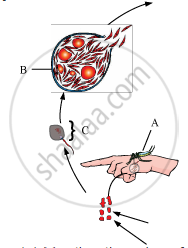Advertisements
Advertisements
Question
How does the transmission of the following disease take place?
Amoebiasis
Solution
The disease called amoeba or amoebic dysentery is caused by a protozoan parasite called Entamoeba histolytica found in the large intestine of humans. The symptoms of this disease are constipation, abdominal pain and cramps, stools containing excessive mucus and blood clots, etc. The carriers of this disease are house flies, which carry the parasite from the stools of the infected person to food and food items, thereby contaminating them. Contaminated drinking water and food items are the major sources of infection. To avoid this, rules of hygiene should be followed and food items should be kept covered.
APPEARS IN
RELATED QUESTIONS
Study a part of the life cycle of malarial parasite given below. Answer the questions that follow:

(a) Mention the roles of ‘A’ in the life cycle of the malarial parasite.
(b) Name the event ‘C’ and the organ where this event occurs.
(c) Identify the organ ‘B’ and name the cells being released from it.
What are the various public health measures, which you would suggest as safeguard against infectious diseases?
Show with the help of a flow chart only, the life cycle of malarial parasite in humans.
Expand MRI
A 30 year old woman has bleedy diarrhoea for the past 14 hours, which one of the following organisms is likely to cause this illness?
Which of the following disease is spread through droplet nuclei?
Poliomyelitis which causes infantile paralysis enters the body through ____________.
The sporozoite of the malarial parasite is present in _______.
Where do the following events in the life cycle of Plasmodium takes place?
a) Fertilization - _________
b) Development of gametocytes - __________
c) Release of sporozoites - ________
d) Schizogony - _________
List the causative agent, mode of transmission and symptoms for Diphtheria and Typhoid.
Cerebral malaria is caused by ______.
The organisms which cause diseases in plants and animals are called ______.
The clinical test that is used for diagnosis of typhoid is ______.
Certain pathogens are tissue/organ specific. Justify the statement with suitable examples.
Given below are the pairs of pathogens and the diseases caused by them. Which out of these is not a matching pair and why?
| (a) | Virus | common cold |
| (b) | Salmonella | typhoid |
| (c) | Microsporum | filariasis |
| (d) | Plasmodium | malaria |
Explain any three preventive measures to control microbial infections.
“Maintenance of personal and public hygiene is necessary for prevention and control of many infectious diseases”. Justify the statement giving suitable examples.
Ringworm is one of the most common infectious fungal disease in humans. Name any two genera of fungi which cause ringworm.
Write the mode of transmission for the following diseases:
Filariasis
What measure would you take to prevent water-borne diseases?
